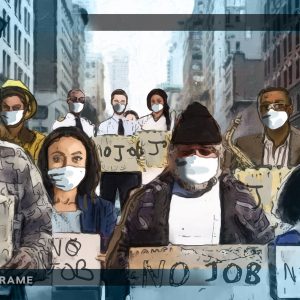Encouraging signs after Covid-19 jobs bloodbath
Unprecedented increases in South Africa’s unemployment levels were largely reversed after the easing of the hard lockdown instituted to curb the spread of the coronavirus.
Author:
17 February 2021

Encouraging new data released on 17 February shows that as South Africa’s Covid-19 lockdown was eased between April and October 2020, its labour market recovered most of the millions of jobs lost after the onset of the pandemic.
The third wave of the nationally representative National Income Dynamics Study – Coronavirus Rapid Mobile Survey (Nids-Cram) shows that the percentage of people employed in October, when the national lockdown had been eased to level one, was comparable to pre-pandemic levels.
The employment level plummeted from 57% in February 2020, before the pandemic, to 48% in April, after the hard lockdown. By October, that figure had rebounded to 55%, which researchers from the universities of Massachusetts Amherst and Oxford called a “startling result”. The significant jobs recovery followed the loss of three million jobs and the impoverishment of millions of people, which had threatened to push South Africa over an economic precipice.
Related article:
Importantly, the recovery appears to have been fairly robust. The data reveal that it has been characterised by previously unemployed people taking up jobs instead of furloughed workers returning to work. It also appears that the recovery has not been driven by an increase in part-time work.
Those left behind
The Nids-Cram data are not all good news, however, as the jobs recovery appears to have laid bare the consequences of South Africa’s grim education inequalities. Young people with a matric, for instance, were more likely to be employed in October (42%) compared with February (29%), whereas those without a matric had lower prospects of employment in October (23%) than in February (28%).
The rebound in employment also appears to have been slower for women than for men, although the data are less certain on this. And while women were more likely to be unemployed in October than men, they were less likely to benefit from the various forms of income support provided by the government during the pandemic. Less than 40% of the beneficiaries of temporary employee and employer relief scheme grants from the Unemployed Insurance Fund were women, and they also made up only 37% of the people who received the social relief of distress grant in October.
Related article:
The social relief of distress grant cannot be received together with other social grants such as the one for child support, which explains why fewer women received it. But researchers analysing the Nids-Cram data argue that “unemployed women have effectively been penalised for collecting the child support grant on behalf of a child as the primary caregiver”.
This gender penalty was likely worsened by the decision to suspend the R500 top-up to child support grants – largely paid to women – in October 2020, while extending the social relief of distress grant – largely paid to men – for another three months.
The data show the reach of South Africa’s social security net, with more than seven in every 10 adults living in a home that received a social grant in October. But it also reveals the impact that ending the pandemic-induced assistance had – and will have – on impoverished families. For example, the suspension of the child support grant top-up in October coincided with dramatic increases in child hunger. In November and December, one in every six homes with children reported that a child had gone hungry during the previous week.
The future of work
Not every lost job has been recovered. Instead, there has been considerable churn in the labour market. One in two people who lost their jobs in April were employed again by October, while around one in every three of those with jobs in October had been unemployed in February.
This suggests that South Africa’s labour market will look very different coming out of the lockdown to what it did going into it. For example, the jobs recovery was driven by an increase in service sector jobs, while employment of manual workers had not yet recovered to pre-pandemic levels.
Related article:
Although no Statistics South Africa employment data are available yet against which to test the Nids-Cram data, production and sales data released by the national statistical service suggest that important sectors of the economy had made a substantial recovery by October. The mining, manufacturing, wholesale and retail sectors, for instance, were making sales in October that were at or above their February 2020 levels.
The figures revealed by Nids-Cram do not yet account for the effect that December’s second, more severe wave of Covid-19 infections and the resulting lockdown will have had on employment. There is every chance that increased restrictions on movement and activity at the start of the new year will have resulted in another increase in unemployment.




